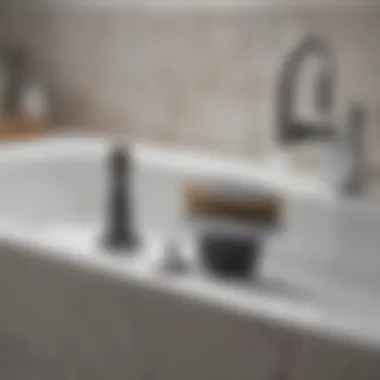Effective Hair Removal Techniques for Bathtubs


Intro
Hair accumulation in bathtub drains poses a significant challenge for homeowners. Slow-draining tubs can lead to frustration and, if ignored, potentially costly plumbing repairs. Understanding how to effectively remove hair from drains is essential for maintaining efficient drainage. This article dives into various methods for hair removal, focusing on practicality and accessibility.
Regular maintenance and prompt intervention can prevent serious drainage issues. This guide aims to provide you with solutions ranging from straightforward manual techniques to utilizing specialized tools and chemical agents. By discussing preventative measures, this article underscores the importance of periodical care in ensuring optimal drain functionality.
Through detailed analysis of these methods, this guide equips both homeowners and maintenance professionals with effective strategies for ongoing drain upkeep.
Understanding the Problem of Hair Clogs
Hair clogs are a prevalent issue in bathtub drains that can cause significant inconveniences. Understanding the nature of these clogs is essential for effectively managing and preventing them. Hair tends to accumulate over time, combining with soap scum and debris, forming a solid mass that obstructs the passage of water. This blockage can lead to slow drainage, which not only disrupts daily routines but can also cause water damage and create a breeding ground for mold and bacteria.
The implications of hair accumulation extend beyond mere aesthetics. Homeowners may face costly repairs if plumbing systems fail due to prolonged neglect of drain maintenance. A proactive approach in tackling this problem can save time and money.
It is beneficial to recognize the characteristics of hair buildup. Knowing that hair can trap other materials, such as skin cells and product residue, leads to a better understanding of drain health. A frequent inspection will help in mitigating long-term issues, ensuring that drains remain functional.
Additionally, educating oneself about best practices for removing hair from drains provides confidence. Whether it’s through manual removal techniques or utilizing proper tools, every effort counts in maintaining a clean drainage system.
"Effective management of hair clogs is not just about fixing problems; it’s about preventing them and ensuring the longevity of your plumbing."
In summary, a thorough understanding of hair clog issues is vital for maintaining a functioning bathtub drainage system. It opens up discussions around efficient removal methods and preventive strategies that can be effectively applied in everyday life.
The Nature of Hair Accumulation
Hair accumulation in drains is a slow process, often unnoticed until significant blockage occurs. As hair falls out during showers and baths, it becomes trapped in the drain. Over time, it can intertwine with other substances like soap and shampoo residues. These combined materials create a dense mass that limits water flow. Recognizing this accumulation early is key to preventing more severe issues.
Many factors contribute to how quickly hair builds up in a drain, including:
- Water temperature: Hot water can dissolve soap residues more effectively, but it also makes hair slippery, allowing it to clump together.
- Frequency of use: High usage means more hair and residues accumulating at a quicker rate.
- Hair types: Certain hair types tend to shed more or tangle easily, increasing blockage likelihood.
Regular cleaning is crucial in addressing hair accumulation. Simple preventive measures can reduce the extent of the problem significantly.
Common Causes of Drain Blockage
Many elements contribute to drain blockage, with hair being a prominent factor. Common reasons for clogs include:
- Excessive Hair Shedding: This can occur due to seasonal changes, health issues, or hair treatments.
- Soap Scum: As soap mixes with water and air, it can harden and combine with hair, forming a more stubborn blockage.
- Poor Drain Design: Sometimes, the design of the drain itself can predispose it to faster accumulation of hair and debris.
- Neglect of Regular Maintenance: Many homeowners overlook routine checks, allowing small issues to grow into significant blockages.
By understanding these causes, effective strategies can be implemented to minimize hair clogs. Regular cleaning, using hair catchers, and avoiding the disposal of incompatible materials in drains are practical measures that homeowners can easily adopt. This knowledge equips individuals with the tools necessary to keep their drains functioning properly.


Identifying Symptoms of a Clogged Drain
Identifying symptoms of a clogged drain is essential in maintaining the proper functioning of your bathtub. Recognizing these signs early can save you from more severe plumbing issues down the line. Delays in addressing minor problems can lead to full blockages, requiring extensive measures to resolve.
Being alert to warning signs can also guide you in choosing the right method for hair removal or professional assistance. With household drains, especially bathtubs, the risk of hair accumulation is high. Understanding the symptoms helps to mitigate future issues and maintain a free-flowing drainage system.
Slow Drainage: A Warning Sign
Slow drainage is one of the most evident warnings indicating a potential clog. If you notice that water takes longer to drain than usual, this is an initial red flag. Hair often begins to accumulate in the drain pipes after washing, leading to minor build-up over time. A slow-draining tub can hint that the passageway is partly obstructed.
To assess the situation, observe how quickly water drains after running it for a short time. If water remains standing in the tub for an extended period, it’s advisable to take action. Ignoring slow drainage may not only worsen the situation but can also expose your plumbing to further complications, such as leaks.
Unpleasant Odors: Indicators of Trouble
Unpleasant odors emanating from your bathtub can point to several issues, including hair clogs. Hair can mix with soap residue and other debris, creating a smelly blockage that needs attention. If you notice foul odors rising from the drain, it signifies that there is stagnation in the pipes, often due to hair accumulating and decomposing.
To tackle bad smells, it’s important to address the underlying issue promptly. Using a mixture of baking soda and vinegar can temporarily alleviate odors while serving as a form of cleaning for your drain. However, this is not a permanent solution. If the smells persist, a deeper assessment of the drain may be necessary. Regularly inspecting for hair build-ups can prevent these situations from recurring.
Key Takeaway: Stay vigilant for signs like slow drainage and unpleasant odors. Early detection of these symptoms can simplify hair removal and keep your drains functioning properly.
Manual Removal Techniques
Manual removal techniques are essential in tackling hair clogs effectively. When faced with slow-draining tubs, often the first line of defense should involve hands-on methods. These approaches not only promote immediate relief from blockages but also foster a thorough understanding of how hair accumulates in drains. By utilizing tools that facilitate manual removal, homeowners can address issues directly and minimize long-term maintenance challenges.
Using a Hair Catcher
A hair catcher is a straightforward yet useful tool to prevent hair from getting into the drain. It is typically placed over the drain opening and captures hair before it can accumulate. Benefits include reducing the frequency of clogs and allowing for easy cleanup. Additionally, they are often inexpensive and simple to install, making them accessible for anyone.
Considerations when using a hair catcher involve ensuring that it fits well within the drain size. Regular maintenance is necessary, as hair will still tend to build up on top of the catcher. Just pulling off the accumulated hair offers immediate results and can prolong drainage efficiency.
Employing a Hook or Plumber’s Snake
A hook or a plumber's snake is an invaluable tool when hair has already accumulated in the drain. The hook can snag and pull out hair clumps, effectively eliminating stubborn clogs. On the other hand, the plumber’s snake allows for deeper access into the plumbing system. It is particularly useful in reaching problematic areas further down the pipe.
Using a hook requires some basic skill. Users need to insert and maneuver it carefully to avoid damaging the pipe. Benefits include a direct approach to removing debris without the use of harsh chemicals, thus preserving the integrity of the plumbing.
Considerations involve familiarity with the tools. Understanding how to effectively use a plumber’s snake minimizes the risks associated with improper usage, such as breaking or jamming it in the drain.
Disassembling the Drain Cover
Disassembling the drain cover offers a thorough method to access clogs and accumulated hair. This technique allows for full visibility of the drain's condition. By removing the cover, homeowners can also clean any underlying issues directly, which may not be accessible through other methods.


Benefits include the ability to address accumulation deep within the drains that hair catchers and hooks may miss. The disassembly process also facilitates necessary inspections of the plumbing.
Considerations include ensuring that the appropriate tools are available and being cautious about the fittings used to secure the cover back on. Improper reassembly can lead to future leaks or blockages. It is also beneficial to familiarize oneself with the specific type of drain cover being encountered, as designs often vary.
Always remember that a proactive approach to drainage maintenance saves time and effort in the long term.
By employing these manual removal techniques, individuals can enhance the longevity and efficiency of their bathtub drainage systems. These methods empower homeowners to take charge of maintenance, resulting in a more pleasant bathing experience.
Chemical Solutions for Hair Removal
Chemical solutions play a crucial role in tackling hair accumulation in bathtub drains. Often, manual methods alone might not fully resolve stubborn clogs. Chemical cleaners can penetrate hair and soap scum, effectively breaking them down. This can restore the drain's functionality without requiring significant labor. Moreover, using these products can be time-efficient. Homeowners appreciate solutions that allow them to resolve issues quickly, and chemical cleaners typically provide instant results.
When considering chemical cleaners, it is essential to weigh the benefits against potential drawbacks. Using these products improperly can lead to damage to plumbing systems. Harmful chemicals can also impact the environment negatively if not disposed of correctly. Therefore, understanding the types of cleaners available, as well as adhering to safety precautions, is vital.
Types of Drain Cleaners Available
There are several types of drain cleaners on the market. Each type corresponds to specific needs and situations. Here are the common types:
- Enzymatic Cleaners: These utilize natural enzymes to break down organic material, such as hair and grease. They are often eco-friendly and safe for pipes, making them a popular choice for regular maintenance.
- Caustic Cleaners: Containing strong alkaline substances, these cleaners can dissolve hair and other organic matter effectively. However, they require caution due to their potential to damage pipes if misused.
- Acidic Cleaners: These work by using acid to dissolve blockages. They are powerful and must be used sparingly to avoid corrosion of plumbing materials.
- Foaming Cleaners: These cleaners expand and cling to the sides of pipes. They can clean from the sides and help reach debris that might not be directly accessible.
Each type of cleaner has its specific use case. Choosing the right product is important for efficiency and safety.
Safety Precautions When Using Chemicals
Using chemical solutions safely is paramount. Hazards can arise from improper chemical handling. Take the following precautions to minimize risks:
- Read Labels Carefully: Always follow instructions on the label. This includes dilution ratios, application methods, and contact warnings.
- Wear Protective Gear: Gloves, goggles, and masks can protect your skin, eyes, and respiratory system from harmful chemicals.
- Ventilate the Area: Ensure good airflow in the area where chemicals are in use. This reduces the risk of inhaling toxic fumes.
- Never Mix Chemicals: Combining different types of drain cleaners can create dangerous reactions. It is best to use one product at a time.
- Dispose of Chemicals Properly: Follow disposal guidelines provided with the product. This minimizes environmental impact and helps comply with local regulations.
"Safety first: Understanding chemical usage can help you avoid potential hazards, ensuring a clean and functional drain without the risk of harm."
Preventative Measures to Avoid Hair Clogs
Preventative measures are crucial when dealing with hair clogs in bathtub drains. By taking proactive steps, homeowners can significantly reduce the chances of experiencing drainage issues in the future. Understanding the importance of prevention minimizes potential plumbing problems that can arise from hair buildup, ensuring a more functional and convenient living space.
Regular Cleaning Routines
Having a regular cleaning routine for your bathtub drain can make a substantial difference in avoiding hair clogs. Here are specific steps you can incorporate into your cleaning habits:
- Weekly Maintenance: Perform a simple check of the drain once a week. Wipe away any hair or debris that may have accumulated around the drain.
- Deep Clean: Monthly, perform a more thorough clean by using a drain cleaner or a solution of equal parts vinegar and baking soda. This method not only helps break down minor blockages but also keeps the pipes clear of future build-up.
- Check for Hair Catchers: If hair catchers are in your bathtub, clean them regularly. This will not only prolong their lifespan but also maintain their effectiveness.


Planning these cleaning activities into your routine can help in identifying and addressing potential issues before they become major blockages.
Use of Drain Covers
Using drain covers is an essential preventative strategy that can not be overlooked. These simple coverings are effective in intercepting hair before it enters the plumbing system. There are various types of drain covers available, and selecting the right one can immensely aid in keeping your drains free of clogs. Consider these benefits:
- Easy Installation: Most drain covers can be easily installed with minimal effort. They simply sit atop your drain and require no tools.
- Cost-Effective: Investing in a drain cover is inexpensive compared to the cost of professional plumbing services for unclogging drains.
- Variety of Designs: Choose from a range of designs. Some are specifically made for hair containment, while others have fine mesh that traps small particles.
Maintaining the habit of using drain covers along with regular cleanings creates a fortified approach towards keeping your bathtub drain in optimal condition.
By combining regular maintenance with tools like drain covers, homeowners can effectively reduce the risk of hair clogs.
Both strategies play a crucial role in ensuring that drains remain functional and that water flows freely, ultimately leading to a better bathing experience.
Maintenance Practices for Keep Drains Functional
Maintaining the functionality of bathtub drains is crucial in preventing hair clogs and promoting an efficient drainage system. Regular maintenance practices help to mitigate the buildup of hair and other debris, ultimately leading to a smoother and more effective plumbing system. The importance of consistent care cannot be overstated; it not only saves time and money on costly repairs but also enhances the overall hygiene of your bathroom.
Key elements of effective maintenance include scheduling routine inspections, utilizing suitable tools, and being mindful of usage patterns. Consideration of these factors ensures that drains remain clear, and potential blockages are identified before they escalate into more significant problems.
Scheduling Routine Inspections
Routine inspections play a vital role in maintaining your bathtub drains. These inspections allow for the early detection of any signs of hair accumulation or other potential issues. Regular checks can be performed at least every six to twelve months as part of a broader home maintenance schedule.
Here are some simple steps to follow when conducting an inspection:
- Visual Inspection: Check for any noticeable hair accumulation around the drain cover or within the visible pipes. This can often indicate a developing clog.
- Water Flow: Run water for a few minutes and observe the drainage speed. If it slows down significantly, this may signal a blockage.
- Listen for Sounds: Unusual sounds such as gurgling can indicate air trapped in the pipes, pointing towards a potential blockage.
By establishing a routine for inspecting your drains, you can take proactive measures and maintain optimal functionality. Catching problems early on will save extensive time and effort later.
How to Decide Between DIY and Professional Help
Choosing between DIY solutions and enlisting the help of professional services can be challenging. Here are some considerations that can guide your decision:
- Severity of the Problem: If the issue is minor, such as a small hair buildup, DIY methods like using a plumber's snake or chemical drain cleaner may suffice.
- Expertise and Tools: Evaluate your comfort level with DIY tasks. If you have the right tools and knowledge, you may successfully handle the situation yourself. However, lacking either means it might be best to consult a professional.
- Time Constraints: Consider how much time you can dedicate to solving the issue. Professionals can usually resolve plumbing issues more quickly due to their expertise and experience.
- Safety Concerns: Some drainage issues may have underlying causes, such as damaged pipes, that require specialized knowledge for safe and effective resolution.
The End
Summarizing Key Strategies for Drain Maintenance
Several strategies have emerged as critical takeaways from our discussion. Here they are:
- Regular Cleaning Routines: Establishing a cleaning schedule that includes regular removal of hair and debris is vital. This may involve utilizing tools like hair catchers or even routine inspections of drain covers.
- Using Drain Covers: Investing in quality drain covers can significantly reduce hair and debris entering your drains. These covers act as a first line of defense against clogs.
- Employing Manual and Chemical Solutions: Knowing when to use manual removal techniques versus chemical solutions is important. Manual removal allows for targeted resolution of clogs while chemicals can help in maintaining overall drain health, but should be used cautiously.
- Scheduling Professional Inspections: While many DIY methods are effective, consider having professional check-ups periodically. They can help identify issues that you may not spot on your own. This can save you time and money in the long run.
Remember: Regular maintenance and proactive measures are key to avoiding serious plumbing issues. By implementing these strategies, you ensure not only the optimal function of your drains but also the overall health of your home plumbing system.
In summary, handling hair accumulation in bathtub drains is a manageable task with the right approach and tools. Keeping drains clear not only benefits your bathing experience but also preserves the integrity of your plumbing system. Homeowners should prioritize these practices to enjoy a trouble-free bathroom environment.







